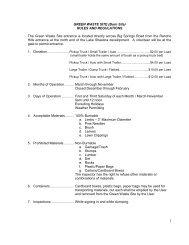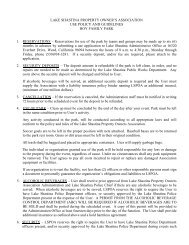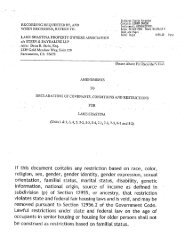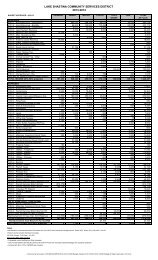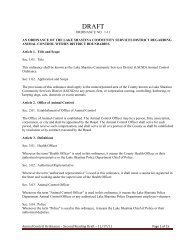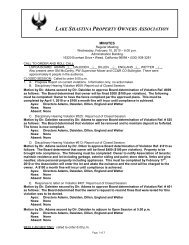Lake Shastina Community Services â Snow Removal
Lake Shastina Community Services â Snow Removal
Lake Shastina Community Services â Snow Removal
You also want an ePaper? Increase the reach of your titles
YUMPU automatically turns print PDFs into web optimized ePapers that Google loves.
<strong>Lake</strong> <strong>Shastina</strong> <strong>Community</strong> <strong>Services</strong> – <strong>Snow</strong> <strong>Removal</strong><br />
During snow events, the <strong>Lake</strong> <strong>Shastina</strong> Public Works personnel are continuously monitoring road conditions throughout<br />
the community. Our crews are on call around the clock to efficiently clear roads and address issues as they arise.<br />
Our office staff has a designated priority system for plowing. First and foremost, primary roads & roads with steeper<br />
slopes are maintained, followed by longer secondary roads and then roads with excessive shade where ice patches may<br />
form, followed by cul‐de‐sac roads.<br />
During these inclement weather conditions, if residents or business owners have concerns regarding the level of service<br />
they are receiving or concerns related to poor road conditions, they may report their concerns by calling 938‐3281. If<br />
you are experiencing a problem after‐hours, you may call 938‐4113. Please know that we will address your issue as soon<br />
as possible.<br />
To help snow removal crews accomplish their job in the most efficient manner, the <strong>Community</strong> <strong>Services</strong> District offers<br />
these tips:<br />
• Delay non‐essential travel until after the roads have been cleared.<br />
• When using a snow blower or plow to clear your driveway, do not put the snow in the street<br />
• To avoid shoveling your driveway entrance twice, wait until the plow truck is finished plowing the street before<br />
you shovel the end of your driveway. The plow truck operator has no choice in where to put the snow. It has to<br />
go off to the side of the road which may include your driveway entrance.<br />
• Do not park on the street during a snow emergency; remove any obstruction from the right‐of‐way that would<br />
impair a Public Works vehicle.<br />
Please be especially careful and courteous when driving around Public Works vehicles. Remember these tips:<br />
• Drive slowly, pass plows only with extreme caution, and never drive into a snow plow's cloud.<br />
• Don't assume the snow plow operator can see you. Every truck has blind spots which reduce side and rear<br />
visibility.<br />
• Allow plenty of stopping distance; don't follow too closely. This also reduces the chance of loose materials<br />
hitting your vehicle.<br />
• Keep your headlights on low beam.<br />
<strong>Lake</strong> <strong>Shastina</strong> Property Owner’s Association would like to stress that with your assistance and cooperation, snow<br />
plowing can be done better, faster, more efficiently, and at the same time, make our streets safer for you. We are<br />
always here to serve you better.
Weather.com offers the following tips for driving safely on icy roads:<br />
1. Decrease your speed and leave yourself plenty of room to stop. You should allow at least three times more<br />
space than usual between you and the car in front of you.<br />
2. Brake gently to avoid skidding. If your wheels start to lock up, ease off the brake.<br />
3. Turn on your lights to increase your visibility to other motorists.<br />
4. Keep your lights and windshield clean.<br />
5. Use low gears to keep traction, especially on hills.<br />
6. Don't use cruise control or overdrive on icy roads.<br />
7. Be especially careful on bridges, overpasses and infrequently traveled roads, which will freeze first. Even at<br />
temperatures above freezing, if the conditions are wet, you might encounter ice in shady areas or on exposed<br />
roadways like bridges.<br />
8. Don't pass snow plows and sanding trucks. The drivers have limited visibility, and you're likely to find the road in<br />
front of them worse than the road behind.<br />
9. Don't assume your vehicle can handle all conditions. Even four‐wheel and front‐wheel drive vehicles can<br />
encounter trouble on winter roads.<br />
If your rear wheels skid...<br />
1. Take your foot off the accelerator.<br />
2. Steer in the direction you want the front wheels to go. If your rear wheels are sliding left, steer left. If they're<br />
sliding right, steer right.<br />
3. If your rear wheels start sliding the other way as you recover, ease the steering wheel toward that side. You<br />
might have to steer left and right a few times to get your vehicle completely under control.<br />
4. If you have standard brakes, pump them gently.<br />
5. If you have anti‐lock brakes (ABS), do not pump the brakes. Apply steady pressure to the brakes. You will feel<br />
the brakes pulse — this is normal.<br />
If your front wheels skid...<br />
1. Take your foot off the gas and shift to neutral, but don't try to steer immediately.<br />
2. As the wheels skid sideways, they will slow the vehicle and traction will return. As it does, steer in the direction<br />
you want to go. Then put the transmission in "drive" or release the clutch, and accelerate gently.




